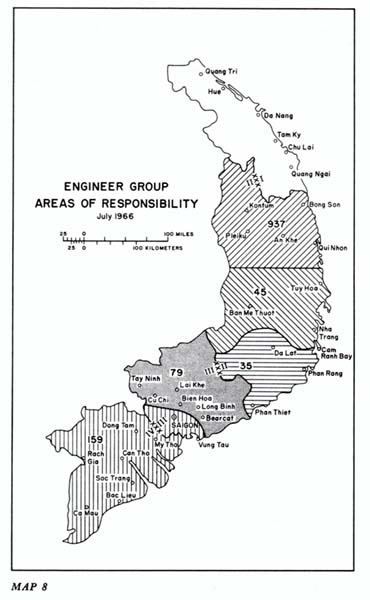
MAP 8
CHAPTER IX
Engineer Tactical Operations
The most direct factors governing engineer construction capability in the Republic of Vietnam were men, materials, and equipment. The last two items were in short supply throughout the early phases of the construction program but became more plentiful in 1966 as the logistical situation improved steadily and as more base and port development projects neared completion. With control of materials and equipment vested elsewhere, the improvement in quality or quantity of manpower remained the most likely means for early increases in the construction capability of the 18th Brigade. But there were prospects of loss of know-how among its units.
During April and May 1966 a significant proportion of the engineer troops in South Vietnam were nearing the end of their twelve-month tours of duty. The loss of so many seasoned men at approximately the same time threatened the operational expertise of many units. To lessen the effect of this "rotational hump," the several group headquarters initiated programs of which the measures taken by the 45th Group were representative. The primary goal of the group was to prevent one month's rotation from exceeding 25 percent of any one battalion's strength. Four steps were taken to accomplish this goal: an overstrength of 10 percent was authorized for the battalion; some individual tours of duty were shortened by as much as one month, allowing the administrative load to be spread over at least two months; the tours of 10 percent of the men eligible for rotation were voluntarily or involuntarily extended for one month or longer if necessary; and soldiers were interchanged with men in other battalions who had less Vietnam service in order to lessen the impact of the loss on any specific battalion.
To maintain the manpower resources capable of sustaining operational support, General Ploger agreed to soldiers with nonengineer military occupational specialties as fillers. He also requested and obtained temporary authorization for an overstrength of between 10 and 15 percent, since a 15-percent overstrength could be economically employed without augmenting equipment. The temporary increase in personnel enabled engineer commanders to
[130]
take full advantage of the dry season to complete as much construction as possible before the monsoon weather curtailed activity. Local Vietnamese laborers and some from other countries, primarily Filipinos, were employed whenever and wherever possible, but their use had several drawbacks. South Vietnam was traditionally an agricultural country and its people lacked most of the skills common to a more technological society. There was very little skilled labor available to the South Vietnamese Army. The civilian contractors, who had preceded the Army engineers to Vietnam by several years, had exploited the skilled labor market to such a degree that most indigenous workers employed by the Army could be used only on jobs requiring few or no technical skills. Nonetheless, the Vietnamese proved to be industrious, easily adaptable people, eager to learn and contribute.
Engineer units came to realize the potential of the local nationals, and several training programs were initiated to instruct them in such skills as carpentry, masonry, mechanics, and vehicle operation. Eventually Vietnamese workers were providing valuable assistance throughout the construction program. By late 1966 the 159th Engineer Group was graduating a class of heavy equipment operators every two weeks, and thus alleviating a serious shortage which existed among military men in that particular specialty. Not only did the training of formerly unskilled Vietnamese increase the Army's construction capability, it also provided a base of skilled workers who, once the war was over, could put their experience to good use in developing their nation. Their contributions to the future growth of the South Vietnamese economy would be substantial.
On 8 June 1966, the 45th Engineer Group headquarters arrived at Cam Ranh Bay, breaking the drought in the deployment of engineer organizations from the United States that had lasted nearly five months. After establishing its command post at Dong Ba Thin, the group assumed command of the 20th and 39th Combat Engineer Battalions as well as two light equipment companies and a dump truck company from the 35th Group.
Not long after the arrival of the 45th Group, headquarters of the 79th Engineer Group (Construction) was deployed from Fort Lewis, Washington, arriving in Vietnam in July. The 168th and 588th Engineer Battalions (Combat) were attached to the 79th Group with added support acquired from the 362d and 577th Engineer Companies (Light Equipment). In September the 79th assumed command of the newly arrived 27th Engineer Battalion (Combat), and in October the 86th Engineer Battalion (Combat). The addition of two more group headquarters, while increasing
[131]
[132]
engineer capability, put an added burden on the headquarters staff of the 18th Brigade. The brigade had expanded to include five groups with a total of seventeen battalions. A redistribution of areas of responsibility was effected in order to apportion the work load as equally as possible.
By early 1966 three principal bases of logistical support had been established in Vietnam. Qui Nhon, supported by the 937th Engineer Group, was the primary base of nondivisional strength in the northern II Corps area. The 35th Group at Cam Ranh Bay was geared to the support of the southern region of II Corps. The Saigon-Long Binh complex manned by engineers from the 159th Group was responsible for both the III and IV Corps. While their support was never completely limited to their respective field force elements, most of each group's activities took place within the bounds of the particular tactical zone it supported. When the 45th Group arrived, its immediate area of responsibility included Tuy Hoa, Dong BA Thin, Ninh Hoa, and the northern Cam Ranh peninsula, thus relieving both the 937th and 35th Groups of some responsibility. The 79th was given responsibility for nondivisional engineer activities in northern III Corps, thereby assisting the 159th Group.
Coordination of the various group activities became increasingly difficult for brigade headquarters at Tan Son Nhut. To establish a better position from which to manage the efforts of the entire brigade, the 18th moved a task group to Dong BA Thin, establishing northern headquarters for the brigade on November 18th. With five group headquarters, eighteen battalions, twenty-one companies, seven detachments, and two separate platoons to supervise, it was time for a modification of the command structure to relieve the strain on the overburdened 18th Brigade headquarters.
On 1 December 1966, using personnel from the headquarters of the 921st Engineer Group (Combat) which had remained uncommitted since its arrival in midsummer, the U.S. Army Engineer Command, Vietnam (Provisional) (USAECV), was established, subordinate to U.S. Army, Vietnam, but operating with considerable independence. (Chart 4) The 18th Brigade colors were shifted to Dong BA Thin and the north headquarters was dissolved. On 20 December the Engineer Command moved from Tan Son Nhut to establish its headquarters at Bien Hoa in response to General Westmoreland's promptings to all the headquarters within Saigon to move elsewhere. Soon there was a scheduled exodus, known as MOOSE, an acronym for "move out of Saigon expeditiously." The entire Army headquarters began to move, principally into the Long Binh area, creating a sudden crush of new construction require-
[133]
CHART
4-ORGANIZATION, U.S. ARMY ENGINEER COMMAND,
DECEMBER 1966
1The provisional headquarters of the United States Army Engineer Command, Vietnam, reduced the span of control from five to three major subordinates.
ments for the engineer units in the Saigon area. The Engineer Command was the first major headquarters to move and settled quickly into a partially completed tent and prefab cantonment which had been scheduled for construction in early 1965 by contract to provide housing for the 173d Airborne Brigade. The 62d Engineer Battalion (Construction) was moved from Phan Rang to Long Binh at the cost of one month's production to help in the MOOSE program.
[134]
CHART
5-ORGANIZATION, U.S. ARMY ENGINEER COMMAND,
NOVEMBER 1967
1operational control, Americal Division
2operational control, II Field Force, Vietnam
3The Army Engineer Command remained a provisional organization, lacking the approval of the Office of the Secretary of Defense
The Engineer Command drew further personnel from the 18th Brigade, including its commanding officer. In ceremonies conducted at Tan Son Nhut, Major General Robert R. Ploger, recently promoted, assumed command of U.S. Army Engineer Command, Vietnam (Provisional), while his former deputy commander, Colonel Paul W. Ramee, succeeded him as commander of the 18th Brigade. Still additional engineer headquarters positions were filled from the U.S. Army, Vietnam, Engineer Section, which was dissolved with the formation of the new command. The 921st Engineer Group headquarters remained on the books, uncommitted, as a basis for personnel requisitions until its inactivation much later.
[135]
Under the new arrangement, the Engineer Command directed the operations of the 18th Brigade headquarters as well as those of the 79th and 159th Groups. The 18th Brigade, in turn, exercised command over the 35th, 45th, and 937th Groups. (Chart 5) Necessary engineer support of I Field Force was handled by the 18th Brigade while the Engineer Command worked primarily with II Field Force. In both cases the groups continued to deal with the tactical commanders, providing assistance as requested. Areas of responsibility for the brigade and groups were established, with the 18th Brigade responsible for all of II Corps, the 159th Group responsible for the Saigon-Long Binh-Vung Tau-Dong Tam area, and the 79th Group responsible for the remainder of III and IV Corps.
The shift of the 18th Brigade from Saigon to Dong BA Thin was soon followed by a shift of boundaries within the new brigade area. (Map 9) Headquarters, 937th Group, moved inland from Qui Nhon to Pleiku and assumed responsibility for all the Central Highlands; Headquarters, 45th Group, then moved from Tuy Hoa to Qui Nhon to fill the gap in the northern half of coastal II Corps created by the move of the 937th. The 35th Group extended its responsibility from Cam Ranh Bay to north of Nha Trang.
In its new area, the activity of the 18th Brigade was split between combat support and construction in a 35 to 65 percent ratio. (The proportion of combat support showed a notable rise from the 10 to 15 percent being contributed at the end of 1965.) Combat support operations centered on building new air and ground lines of communication and maintaining those already in existence. Major construction effort was directed to the expansion at Qui Nhon and Cam Ranh Bay.
The 159th Construction Group concentrated on improving the continuously expanding logistical complex at Long Binh and developing the port at Vung Tau. In late 1966, as a result of the arrival of the 9th Infantry Division, the group shifted some of its efforts to new construction in the Long Thanh and Dong Tam areas. With the acquisition of another construction battalion and construction company, the 159th became almost completely organized for and oriented to construction. In recognition of this, the group's responsibility was reduced in January 1967 so that it consisted of only the area around Long Binh and Saigon.
The 79th Construction Group continued to support construction at the base camps of the 1st and 25th Divisions. The group's area of responsibility expanded by January 1967 to include all of the II Corps Tactical Zone except those base complexes under construction by the 159th Group. Shifting frequently from construc-
[136]
[137]
tion to combat support, the group made sizable contributions to Operations CEDAR FALLS and JUNCTION CITY.
The engineer command and control structure in the Republic of Vietnam was significantly strengthened again during 1967 with the arrival of Headquarters, 34th Engineer Group (Construction) , from Fort Lewis, Washington, on 23 March, and Headquarters, 20th Engineer Brigade, on 3 August. Two additional battalions and several separate companies had joined these units by early fall.
The arrival of a second brigade headquarters allowed U.S. Army Engineer Command, Vietnam, to place the groups operating in III and IV Corps under the control of one headquarters, thereby reducing to two the number of headquarters reporting directly to the command. The new structure also allowed the engineer organization to parallel that of the tactical field forces. With the 20th Brigade headquarters at Bien Hoa and the 18th Brigade at Dong BA Thin, the brigade areas of responsibility now coincided with the tactical areas assigned the two field force commands. This new arrangement facilitated the engineer support needed by the two tactical commands.
The distribution of effort within the Engineer Command continued to shift emphasis from construction to combat support and lines of communication upgrading. The arrival of three land clearing platoons by the summer of 1967 permitted a commitment to large-scale jungle clearing operations in both field force areas. The arrival of six construction battalions and three asphalt platoons boosted the progress in upgrading of the land lines of communication to new levels. Under the approved program all critical highways in South Vietnam were to be upgraded to two-lane paved surface roads with permanent steel beam bridges installed as required. Of first consideration was the vital National Route 1 which paralleled the entire coastline north of Saigon.
In the construction field, Army engineers inherited a muchneeded windfall of equipment from civilian contractors when a cutback in funds forced the contractors to phase down operations. With the equipment, however, the engineers also inherited the projects already begun by the contractors.
As the Engineer Command continued to expand in the summer of 1967, the organization and functions of its staff underwent a series of changes. On 10 June General Westmoreland, as U.S. Army, Vietnam, commander, directed that the USARV Engineer Section be reestablished. The Commanding General, U.S. Army Engineer Command, Vietnam, was then formally designated U.S. Army, Vietnam, Engineer, a position he had held in fact if not in title. Under
[138]
this new organization, the Engineer Section was essentially the planning staff and the Engineer Command staff functioned as the operating staff. After reorganization, the Engineer Section moved from Bien Hoa to Long Binh to occupy a portion of the newly completed headquarters building complex of U.S. Army, Vietnam.
The first two months of 1967 saw the beginning of the war's two largest operations to date, CEDAR FALLS in the Iron Triangle and JUNCTION CITY in War Zone C. CEDAR FALLS, conducted in January 1967, began as a battalion operation and ended with two divisions and three separate brigades involved in destroying the enemy in what had been one of his strongest sanctuaries. As part of this operation, for the first time in the war the engineers virtually eliminated large areas of jungle, clearing nine square kilometers. To do this the 1st Engineer Battalion, 1st Division, developed and, with the support of the 79th Group, tested the "dozer-infantry team" concept in which bulldozers, equipped with the newly introduced Rome Plow and previously used only in relatively secure areas, actually became part of the assault force.
[139]
During one phase of Operation CEDAR FALLS an engineer task force consisting of 300 men from the 1st Division, including some of the divisional engineers, and 300 men from the 79th and 159th Groups was organized into clearing teams to operate under four field control centers in separate areas within the Iron Triangle, a Viet Cong stronghold thirty-five kilometers north of Saigon. During the eighteen days in which the task force operated, teams of two tank dozers followed by six conventional dozers, some equipped with Rome Plow blades, moved with the infantry to cut and clear 2,233 acres and checkerboard the area with landing zones to support future operations.
Engineer activity in Operation JUNCTION CITY closely followed that in CEDAR FALLS, with the locale shifting from the Iron Triangle to War Zone C in Tay Ninh Province. The 65th Engineer Battalion of the 25th Infantry Division conducted the major clearing operations, constructing landing zones and bridges as the area was cleared. The battalion also maintained sixty-six kilometers of roadway in addition to providing the normal minesweeping and demolition teams. During the operation Army engineers built three airfields capable of handling C-130's and established two new Special Forces camps to guard the airfields and provide continuing surveillance of the area.
As more and more engineers arrived in Vietnam and the pressures of mounting tactical responsibilities grew in each of the two field force commands, operational control of nondivisional engineer units became increasingly a matter of debate and concern. Although combat divisions had organic engineer units under their direct control, many felt that the work load and demands being placed upon the field force called for additional units to insure rapid response to critical tactical situations.
From the time of their introduction in Vietnam and specifically since the arrival of the 18th Engineer Brigade in September of 1965, nondivisional engineers had divided their efforts between combat support and base development. The massive effort required in base development made engineer officers resist the transfer of any of the scant number of their units to the tactical headquarters of the field forces. General Ploger and his immediate superior, General Engler, deputy commander of U.S. Army, Vietnam, were convinced that engineer units transferred to field force control would lose their maximum construction potential when they were not directly engaged in combat support. Both men felt that the demands of the
[140]
construction program were such that the Engineer Command could not afford to lose any of its production potential.
In the spring and summer of 1967 the entire matter came to a head. Lieutenant General Bruce Palmer, Jr., having just taken command of II Field Force, requested operational control of nondivisional engineer battalions to carry out directly the engineering functions of missions being assigned to tactical headquarters. After investigating the situation, General Engler refused the request on the grounds that the field force had never been able to use more than one and a half support battalions at any one time in tactical operations. He insisted that operational control of engineer battalions remain with the Engineer Command until complete support units could be committed to combat support 100 percent of the time.
During late spring of 1967 General Engler returned to the United States and General Palmer moved from the position of II Field Force commander to that of deputy commander of U.S. Army, Vietnam. Lieutenant General Frederick C. Weyand then became the commander of II Field Force. In an effort to assure his successor direct control of some engineer troop resources, General Palmer moved to formalize a more precise means of identifying engineer support for the field forces. He asked that agreements be drawn up between the field force commanders and the Army Engineer in which particular engineer units were designated "on call" for possible duty in tactical operations.
Lieutenant General Stanley R. Larsen, commander of I Field Force, saw little advantage in the new arrangement. He had been pleased with the response of local engineer units to the needs of the tactical operations in his sector. He felt that an agreement whereby only certain engineer units could be used by his commanders would reduce the flexibility he had enjoyed in previous situations. According to the new proposal, units located in the area of an operation would have to be bypassed while units on call might have to be moved a considerable distance to provide the needed support. The result in I Field Force was the formalizing of an agreement that maintained the same kind of relationship with the area's nondivisional engineer, heading the 18th Engineer Brigade, that had existed before General Palmer's request.
In the south an agreement was drawn up with General Weyand to put two battalions of the 79th Engineer Group, the 168th and the 588th, under the operational control of II Field Force to meet tactical requirements. The 100th Engineer Company (Float Bridge), the 500th Engineer Company (Panel Bridge), and the 362d Light Equipment Company were also earmarked for II Field
[141]
Force. The 79th Engineer Group, which was assigned to the Engineer Command, was still responsible for all formal construction projects assigned these units. The II Field Force maintained operational control for all combat support operations, revolutionary development projects, and lines of communication maintenance and upgrading within the group's area of responsibility. This arrangement was made in June and as of mid-August the identified units reported no significant change in their day-to-day operations.
The method which had evolved for providing engineer support to what corresponded to a corps did not conform with established U.S. Army doctrine. That doctrine prescribed within an interior corps, that is, with other corps on either flank, an engineer structure of at least one group, and perhaps one group per division, commanded by the corps engineer. In South Vietnam, while there was a field force (corps) engineer with his own planning section, he had no assigned troops. Engineer support was furnished after the fashion of that for Army artillery units placed in general support. The two concepts differ in that a corps engineer normally orders subordinate units to carry out prescribed missions, whereas when the corresponding units are placed in general support, the corps engineer requests them to carry out missions but each supporting unit commander may disapprove the request in whole or in part. It is easy to appreciate the uncertainty which might attach to a situation where support units are not commanded by the tactical commander. Even so, in spite of repeated urging to identify deficiencies in the general support system extant in South Vietnam, no field force commander would admit to any lack of engineer support in any operation. In fact, all commanders expressed only praise for the timeliness and efficiency of that support.
The II Field Force continued to exercise operational control of the two combat battalions and three separate companies of the 79th Engineer Group into the fall. On 12 August General Ploger concluded his tour of nearly two years in South Vietnam and was succeeded by Major General Charles M. Duke, who had previously headed the 18th Engineer Brigade. Most operational support requirements of II Field Force during this time had been transmitted through the headquarters of the 20th Engineer Brigade, which had arrived in Vietnam in early August. In a letter to General Weyand, commander of II Field Force, on 16 September 1967, General Duke reiterated that units of the Engineer Command would respond immediately to operational support requirements. When the need for support was urgent, General Duke encouraged the field force commander to transmit his requirements directly to the engineer group or battalion headquarters immediately concerned. All rou-
[142]
tine or planned requirements, however, were to be processed through channels leading to Brigadier General Curtis W. Chapman, Jr., commanding general of the 20th Engineer Brigade.
On 26 September General Duke met with Major General George S. Eckhardt, the deputy commanding general of II Field Force, to discuss again the matter of operational control of engineer units in the two southern corps tactical zones. At this meeting General Eckhardt asked for operational control of combat group headquarters plus all the combat battalions, light equipment companies, and bridge companies in the 20th Brigade. He stated that the operational support requirements in the area had increased to such an extent that a group-size element could be kept fully occupied. General Eckhardt also pointed out that the responsibilities of the field force included the revolutionary development program and the training of Vietnamese Army troops. He suggested that engineers were especially vital in these fields and that since the field force had operational control of all other elements necessary to carry them out, it was only natural that the engineers be placed in the same status.
General Duke was surprised at the new and enlarged request in light of the success that had been evident in past operations. He reaffirmed that he could accept this arrangement only if the field force commander would be willing to account for the formal construction projects assigned these units. This condition was not acceptable to General Eckhardt. His command was a tactical one and could not be concerned with construction programs outside the tactical realm.
Since no new agreement could be reached, the procedure discussed in General Duke's letter to General Weyand remained in effect. Engineer units continued to respond to their primary mission of operational support with the ease and timeliness that made any change in the control arrangements seem unnecessary. Neither the support of tactical operations nor the prosecution of the base development program suffered appreciably. Had more engineer troops been available in South Vietnam, it is possible that their effort could have been completely allocated to assisting field force programs aimed at Vietnamese refugee resettlement, Army training, and civic action.
United States Army Engineer Construction Agency, Vietnam
As a result of field visits by General Harold K. Johnson, former Chief of Staff, U.S. Army, the USARV Engineer Section initiated studies to develop an organization which would centralize control
[143]
over the soaring Military Construction, Army, and facilities engineering costs in Vietnam. By reducing a number of engineer detachments and shifting spaces within U.S. Army, Vietnam, the U.S. Army Engineer Construction Agency, Vietnam, was organized in April of 1968. With the exception of its real estate missions, the construction agency was essentially a management organization, charged with coordinating both military and contractor effort in the areas of real property maintenance and construction. Although the organization was not empowered to award nor to modify contracts for performance by engineering contractors, it provided at each installation serviced by the contractor some representatives of the procurement officer for U.S. Army, Vietnam, who retained authority to award or amend contracts. The Engineer Construction Agency could analyze contractor operations and management in detail and recommend improvements in contracts to minimize costs. This arrangement, with its withholding of contract authority, forced the referral of engineer problems outside the engineer structure.
In the area of construction, the new agency coordinated the military and contractor positions in the USARV Military Construction, Army, program and the USARV portion of the MACV lines of communication program. It provided design, quality control, construction management, and equipment utilization assistance to the construction agencies. The construction agency also assumed the management of the USARV base development program.
The ability of engineers to respond to commanders' requirements for the support of facilities was due largely to the unusual organization of the Army Engineer Construction Agency. With a designated installation engineer in full control of construction organization at each military base, not subject to directive authority of local commanders, more control and emphasis could be placed where limited resources were most effective. The engineers have generally been reluctant to have engineer units attached to combat units for support because of their occasional misuse by tactical commanders who sometimes do not understand the capabilities and missions of engineers. Rather, they are better utilized in the general support role where the engineer command controls over-all priorities and engineer efforts throughout a whole area. The vertical organization of the construction agency placed engineer support of facilities in a similar role and thus retained centralized control of engineer resources. By relieving the installation engineer of the burden of direction and evaluation from tactical commanders, the agency produced better response theater-wide and more stringent
[144]
control over not only facilities engineering services but also minor new construction efforts.
By the end of 1966 the tactical situation in IV Corps made it necessary for the Engineer Command to develop plans for a large base development program in the Mekong Delta region. A location was sought for use as a staging area for operations by U.S. Army tactical units south of Saigon. The site had to be deep enough in hostile territory that the presence of American troops would alone deter enemy activity. It also had to be located in a rather sparsely populated area to reduce the expensive resettlement of local civilians. The problems of tactical resupply and of transporting materials dictated that the base be accessible to a system of navigable waterways. Finally, since during the monsoon season there was virtually no dry land south of Saigon, the site might well be determined by the proximity to a suitable source of fill material. Enough fill would have to be available to raise an area of approximately six hundred acres to a level higher than the watery countryside. It was apparent from geological formations that sand would have to come from a riverbed to provide the needed fill.
A site was finally chosen on the My Tho River about three miles west of the city of My Tho. The land for this camp that became known as Dong Tam was obtained by dredging sand from the Bassac River and pumping it into what had been rice paddies; approximately eight million cubic meters of fill were required.
Company C of the 577th Engineer Battalion arrived at the partially filled Dong Tam site on 21 January 1967 to begin work on the 7,500-man camp and operational base to be manned by troops from the 9th Infantry Division. Mess halls, showers, and latrines were immediately put under construction. To assist in the movement of supplies, two Bailey bridges were placed across an intervening river to connect the camp with the city of My Tho to the east. During the spring of 1967 Company C was joined by engineers of the 169th Engineer Battalion from their previous location at Long Binh and men from the 9th Infantry Division working in the self-help program. By May, 20 percent of the planned construction for Dong Tam had been completed; it included a brigade headquarters, several mess halls, and numerous prefabricated buildings. A 1,670-foot runway enabling fixed wing light Army aircraft and helicopters to bring supplies to the site had also been completed.
A sixty-bed MUST (medical unit, self-contained, transportable)
[145]
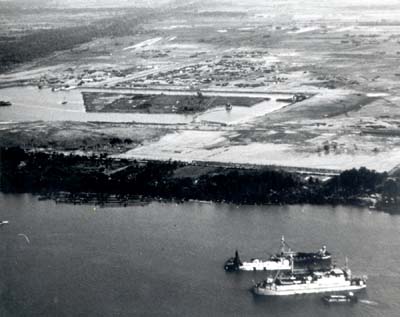
DONG TAM IN EARLY STAGES OF DEVELOPMENT, JANUARY 1967
hospital was begun during the spring. Two inflatable wards had been completed along with a surgical building and supply center when the 169th arrived. A medical helipad was also under construction. The inflatable buildings were susceptible to collapse if punctured and when during an attack an enemy mortar round impacted nearby, two of the key structures were hit by fragments. From the engineer point of view, the added work and materials needed to protect the inflatables raised a serious question as to the utility of the MUST in Vietnam.
Another question raised in the development of Dong Tam (as well as a few other sites) related to the advisability of erecting the standard two-story wooden barracks in view of the vulnerability of the second story to long-range, flat trajectory weapons. The vulnerability was more apparent than real and the trade of ground space for elevation, extra roofs, and roof trusses kept the seemingly safer single story structure from becoming standard. There is no known incident of a soldier being wounded while in the second story.
The summer saw the completion of more permanent buildings, including wood frame billets for hospital personnel and covered
[146]
storage areas. Work was also begun on a water and electrical distribution system and on a waterborne sewage system.
The construction project at Dong Tam was hampered as much by nature as by enemy activity. Changing weather plagued the engineers in the delta at every turn. During the summer and fall the monsoons brought rain and the problems of erosion and mud. During the winter and spring, in the dry season, wind erosion damaged machinery as well as terrain. To stabilize the soil during the monsoon season the engineers of the 169th developed a mixture of sand and concrete to gain the desired surface strength in road and hardstand construction. Concrete curbs were designed with corrugated metal pipe spillways in an effort to reduce extensive damage from excessive runoff. Overland grades were kept at a maximum of 2 percent to minimize erosion. Terraces were sodded or seeded with rice to keep them from washing away in the fall or blowing away in the spring.
As areas were filled sufficiently to raise them above the water table, they were immediately occupied by troops. Living in tents with wooden floors, the infantry soldiers played an important role in the construction program through their own self-help effort.
The building program at Dong Tam necessitated the development of engineering techniques found nowhere else in Vietnam. The instability of the ground in the Mekong Delta required that most large buildings be supported by piles. The extensive use of sand cement was another important innovation. Because concrete aggregate had to be shipped by barge from Vung Tau to Dong Tam, a five- to ten-day trip, it could be used only in the most important concrete structures. The high water table in the area created many other special problems for Army engineers. Holes dug for signal and power poles had to be shored with 55-gallon drums. If the poles were not placed and set immediately, the holes filled with water and new ones had to be drilled.
A peculiar problem also developed in connection with the unusual underground storage tanks installed for protection at the Dong Tam site. Concrete collars had to be placed around the tanks to keep them below ground. Before this precaution was taken, underground storage tanks, suddenly popped out of the ground when their flotation was increased sufficiently by the withdrawal of their contents.
During the summer of 1967 the port facilities in Dong Tam were improved and enlarged considerably. The 41st Engineer Company (Port Construction) built two LCU (landing craft, utility) ramps, an LST ramp, and a pontoon barge and finger pier during the summer. Forty-eight thousand square yards of warehouse stor-
[147]
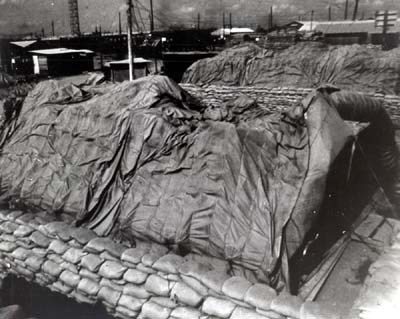
INFLATABLE HOSPITAL BUILDINGS AT DONG TAM DAMAGED BY MORTAR ROUNDS
age, 30,000 square feet of hardstands, and 5,000 square feet of maintenance shops were also completed.
In December 1967 four Navy personnel air cushion vehicles arrived at Dong Tam. The vehicle site consisted of a stabilized ramp, an extensive hardstand area, and two maintenance buildings. The Army engineers completed all approved work on the Dong Tam project by the end of 1968. The engineers there made the first inroad into enemy activities in the Mekong Delta and provided an acceptable base of operations for the men of the 9th Infantry Division.
Army engineer involvement in Vietnam had been limited initially to the II, III, and IV Corps Tactical Zones encompassing most of the southern three quarters of the country.
A substantial incursion into I Corps Tactical Zone developed when in early 1967 the Americal Division was dispatched to Duc
[148]
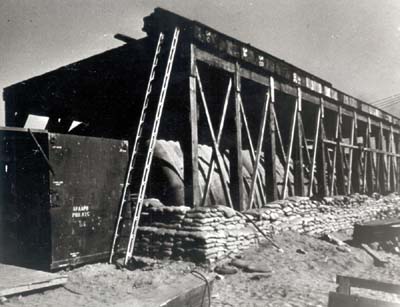
ENGINEERS' SHELTERS FOR INFLATABLE HOSPITAL STRUCTURES AT DONG TAM could
withstand a direct hit by an 81-mm. mortar shell.
Pho, a brigade base site, and Chu Lai. To reach Duc Pho the troops conducted a tactical operation across the beach to their future base one mile inland. There, soon afterward, the 39th Engineer Battalion, which had left its long-established work site at Tuy Hoa and was now attached to the division as its organic engineer unit, worked to develop an airfield for C-130's and for Army helicopters as well as the associated cantonment and logistic support facilities. After a good start at Duc Pho, efforts were made to link up road connections with II Corps Tactical Zone to the south and the Marine and Navy elements to the north. The 45th Engineer Group had its support responsibility extended to include the Americal area of operations. By the end of 1967 new pressures resulting from increased North Vietnamese infiltration across the demilitarized zone forced engineer units to prepare for duty in I Corps. Before this time, troops north of Chu Lai in the northernmost provinces of the Republic of Vietnam had received their engineer support from engineers organic to Marine Corps units in the area and from Navy construction battalions (Seabees).
[149]
In January 1968 the 1st Cavalry Division (Airmobile) was alerted for immediate movement north. The 45th Engineer Group was given responsibility for the additional engineer support during the movement and for sustained support in the I Corps area. (Map 10) Located at Qui Nhon at this time, the group prepared to move north at the height of the enemy Tet offensive and in the midst of the monsoon season. The movement toward the base camp near Hue was complicated by weather that made helicopter flight unreliable and by enemy activities on the ground that made convoy travel extremely hazardous.
The first unit of the 45th to start north was the 35th Engineer Battalion (Combat). Its immediate mission was to move overland, preparing Route 1 for heavy traffic north. The operation was not an easy one considering the level of enemy activity in the northern provinces. The battalion left a landing zone thirty miles north of Qui Nhon on 8 February 1968 to begin the trip up Route 1 toward Da Nang. After reaching DA Nang, the battalion pushed north in an effort to open the Hai Van Pass and the road north of DA Nang as far as Phu Loc. On 12 February advanced units of the 35th reached Ap Nam O, five miles north of DA Nang. Movement farther north became more costly as each mile was opened. Bridges and culverts had been destroyed at many points on the road. Enemy sappers constantly disrupted repair efforts with sniper fire and random mines and booby traps. With assistance from units of the 101st Airborne Division and the 502d Infantry Regiment, the 35th was able to remove the obstacles and replace the damaged bridges by 24 February. On 29 February one company of the 35th linked up with elements of the 32d Naval Construction Regiment working to open the road south from Phu Bai. On 1 March convoys were rolling from DA Nang to Phu Bai for the first time since the beginning of the Tet offensive in early January.
The 14th Engineer Battalion (Combat), located at Cam Ranh Bay, was withdrawn from the 35th Engineer Group to head north. The unit had originally been instructed to prepare to move by sea to Quang Tri where it was to provide support for an over-the-beach logistic operation, but plans had been changed when it was learned that conditions on the beach would not allow the landing of LST's. Fortunately, the 35th Battalion had already opened the road north of DA Nang enabling convoy travel to reach the northernmost areas of I Corps. The 14th was then ordered to travel by convoy to Wunder Beach, just south of Quang Tri. Once the battalion reached its destination, one company was sent inland to provide combat support for the 1st Cavalry Division located at Camp Evans. From the base camp, the remainder of the battalion built roads and
[150]
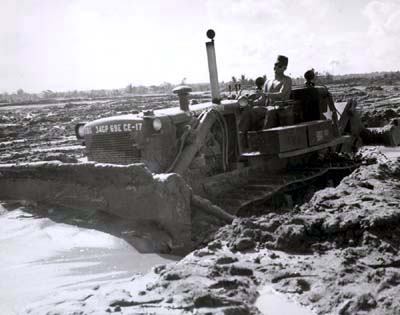
DOZER REDISTRIBUTES SAND DREDGED FROM RIVER
performed other engineering tasks essential for the movement of supplies in preparation for Operation PEGASUS, which was aimed at lifting the siege at Khe Sanh.
The 27th Engineer Battalion, the fourth and last engineer battalion to arrive in I Corps, was assigned the task of providing support to the 101st in the Hue area. Teaming up with the 591st Engineer Company (Light Equipment), the 27th prepared to move from a site known as Blackhorse, thirty miles east of Saigon, by any means of transportation available. Wheeled vehicles were moved by sea to DA Nang, where they were met by drivers flown there by C-130's. The vehicles then were driven in convoy to Gia Le, south of Hue, via the newly opened Hai Van Pass. Heavy equipment was moved by LST directly to Tan My and driven overland to Gia Le. The remaining troops of the 27th were flown directly from Saigon to the Phu Bai airfield near Gia Le. The entire unit reached Gia Le by the middle of April.
The first major task of the 27th Battalion was to support a joint operation by the 1st Cavalry, 101st, and a South Vietnamese airborne brigade up the A Shau valley on Route 547. This task included clearing and opening Route 547 for vehicle traffic and
[151]
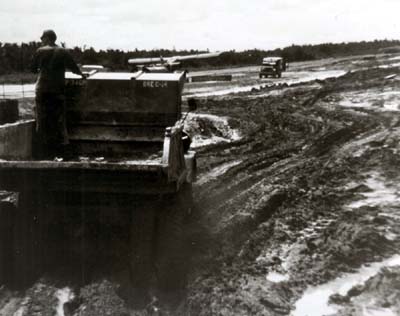
DONG TAM AFTER A TROPICAL RAINSTORM
removing all jungle vegetation within three hundred meters of the roadway. The clearing was accomplished through the coordinated work of platoons of Rome Plows.
The construction of the winding, mountainous Route 547-known as the A Shau Expressway-is an excellent example of the cooperation and coordination involved in the lines of communication program. Route 547 was begun in March 1969 when I Corps tacticians decided the 101st Division needed an all-weather land supply link from the division's base camp near Hue into the A Shau valley, a notorious enemy stronghold. The 27th Engineer Battalion and seven attached companies were assigned to the project and designated the 45th Engineer Group's Tiger Task Force.
Various parts of the road construction job were distributed all along the proposed route. Company C of the 27th installed culverts behind the initial effort of the 59th Land Clearing Company, assisted by helicopters from the 101st Division. The culverts were assembled in the base camps where men and equipment could work freely, and then transported, dangling by hook and line from Chinook helicopters, to the construction site.
[152]
The engineers in Vietnam relied upon innovation and ingenuity, which often were the only means of solving the myriad construction problems they encountered. Land clearing teams along Route 547 had to clear areas bordering the roadway which sometimes dropped off sharply to 60-percent grades. Engineers devised an unusual method of tandem dozing to deal with this situation. Referred to as yo-yo dozing, this method used two dozers; one was positioned on the roadway as an anchor and the other was hooked to the first, rear end to rear end, then lowered over the edge of the slope with its plow pointed straight down to clear a swath through the trees and brush. When the dozer with the plow reached the bottom of the grade, the two dozers reversed their winches and the anchor dozer drew the second dozer back up the grade to begin a new cut. The procedure was repeated until the required 200-meter strip was cleared.
Farther down the road other elements of the battalion constructed a Bailey bridge spanning the Song Bo River. Nearly every facet of road construction was exhibited in the building of Route 547, which was a crucial link in the road system and not merely a
[153]
[154]
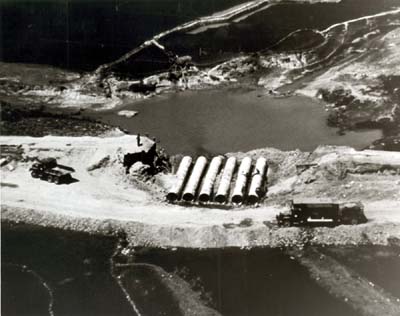
EARTH-FILL BYPASS FOR BRIDGE DESTROYED BY ENEMY. Six-barrel culvert will
replace bridge.
military convenience. After the U.S. forces have left, 547 will remain as a valuable commercial artery for the city of Hue and the people in the surrounding areas.
Army engineer operations now encompassed every province in South Vietnam. From the marshy rice paddies of the Mekong Delta to the mountainous highlands along the demilitarized zone, engineers were hard at work applying their expertise in support of combat operations carried out by the allied military forces and in assisting the Vietnamese people in their efforts to build a nation.
The military assistance program in the Republic of Vietnam was by no means limited to support from the United States. In response to an appeal by President Johnson in 1964, several nations of the Free World came to the aid of the beleaguered people of South Vietnam. The military and nonmilitary engineer contingents of these Free World Military Assistance Forces came from Australia,
[155]
Thailand, New Zealand, the Philippines, and the Republic of Korea and contributed much independent engineer work. Of these countries, Korea furnished the largest engineer contingent. Each Korean division had its organic engineer battalion and one additional battalion known as the Dove Force, a title reflecting its peaceful mission. Based in Ben Hoa Province, this last unit systematically initiated a series of comprehensive local improvement programs oriented toward the improvement of public health, sanitation, rural development, and transportation. The Korean troops "proved themselves adept in establishing a rapport with the local population by stressing the kinship of aspirations and the brotherhood of the Asiatic peoples."
The commitment of the Republic of the Philippines to the welfare of the people of South Vietnam was manifested in August 1966 with the arrival of a 2,000-man Philippine Civic Action Group. Consisting of engineers and medical teams supported and protected by an organic security force, the group assisted the Vietnamese authorities primarily in Tay Ninh Province and to a less visible degree with small teams in several other provinces. During 1967-68 the civic action group cleared a large section of the Thanh Dien forest, long an enemy stronghold, and constructed a model resettlement village for 1,000 South Vietnamese families outside of Tay Ninh city.
Realizing that Thailand could be the next target of communist aggression if Vietnam should fall, the Thai government made its first commitment of combat forces to South Vietnam in early 1967. The Thai engineers, in addition to providing close combat support for the very effective Queen's Cobra Regiment and Black Panther Division, were especially active in civic action programs within their areas of responsibility.
Australia and New Zealand made significant contributions to the physical and social betterment of the Vietnamese people. Thousands of tons of construction materials were made available for local development projects as was the technical assistance necessary to train unskilled local inhabitants.
Before other Free World forces could contribute significantly to the struggle in South Vietnam, U.S. Army engineers laid the groundwork for their allies. Prior to their arrival U.S. engineers initiated construction of base camps and logistic facilities for their support and consistently contributed materials and effort to the allies when their own resources fell short.
Apart from the actual combat troops provided by Free World forces, no less than thirty-five other nations contributed food, medical supplies, equipment, technical advisers, and millions of dollars
[156]
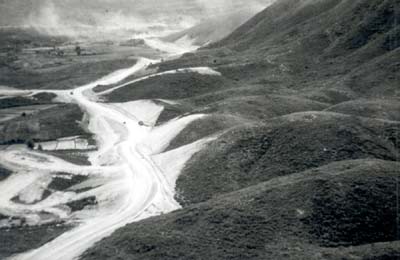
THE A SHAU EXPRESSWAY during upgrading by the 27th Engineer Battalion.
in economic aid to support the Vietnamese war effort. The assistance provided by these nations represented a solid front united in the common purpose of resisting the destruction of one of their own by communist insurgency.
[157]
Go To:
Return to the Table of Contents